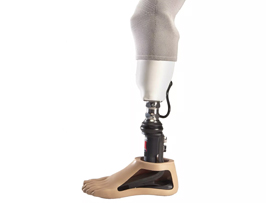Limb loss below the knee means the amputation or absence of the leg below the knee

Below-the-knee (BK) limb loss (also called transtibial amputation) refers to the amputation or absence of the leg below the knee. As you go through this level of amputation, it's important to know your options and remember that it is possible to return to an independent lifestyle.
As you begin your amputation journey, you will work with a prosthodontist who is trained in the design, manufacture, and fitting of below-the-knee artificial limbs (prostheses). It's important to talk to your prosthetist about your goals, expectations, and concerns so he or she can meet your specific needs. If possible, you should try to meet with him before the surgery so you can prepare for the road ahead. Your prosthetist will work closely with your doctor and rehabilitation team to monitor your health and make sure you meet your expected milestones.
Here's an overview of what to expect during your below-knee amputation care journey.
Postoperative Leg Care
Your doctor may prescribe an astringent to help shape your remaining limb and/or an AmpuShield ® to protect your leg from injury and aid the healing process.
First Prosthetic Meeting
Your prosthetist will get to know you and ask about your daily activities. They will listen to your goals and then apply their clinical expertise to design the right prosthesis customized to your specific needs.
First Prosthesis
Once your remaining limb has healed sufficiently, you will be measured and fitted with a prosthesis. The prosthesis you will take home is custom made using materials suitable for your needs. Your prosthodontist will teach you how to wear and care for your prosthesis and consumables.
Physiotheraphy
Your doctor, prosthetist and/or physical therapist will help you learn how to use your prosthesis in your daily activities. Once you are comfortable with basic skills, you can continue with more advanced physical activities such as going up and down stairs, driving, and participating in sports or other hobbies.
Follow-up Care
As your limb changes, your prosthodontist will continue to make adjustments to your prosthesis, including periodic replacements as needed. It is important to see your prosthetist at least every six months to resolve any issues, especially as the size of your remaining limb changes.